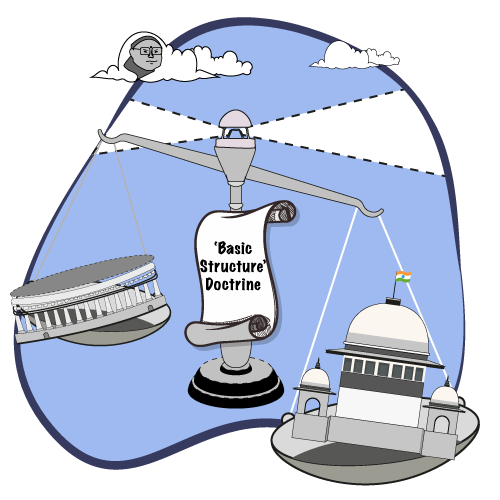Kesavananda Bharati V. Union of India – A Case that India Cannot Forget

Introduction
His Holiness Shri Kesavananda Bharati Sripadagalvaru attained jeeva samadhi at the age of 80. He was an Indian monk who served as the head seer of the ‘Edneer Mutt’ in Kasaragod district of Kerala since the year 19611. Although he was associated and devoted to providing service in the field of religion, His Holiness is the one whose name is taken every time the constitutional debate has sparked in India. It is because His Holiness’ name is associated with one of the iconic and landmark constitutional cases which has been ever argued within the closed walls of the Indian Supreme Court.
The case of Kesavananda Bharati v. State of Kerala2is also known as the Fundamental Rights case of 1973. It was heard by Chief Justice S.M Sikri who constituted 13 judges bench. The case was argued and heard for a span of 68 days in a period of 6 months and the case was finally concluded by pronouncing 11 separate judgments stitched to a tough majority of 7:63. Ironically, His Holiness who was the Petitioner in this case lost his challenge to protect the land owned by the Mutt he represented from its acquisition by the Kerala state Government by virtue of Kerala Land Reforms Act, 1963 which was further amended by Kerala Land Reforms (Amendment) Act, 1969; however, the case, in turn, was a big win that led to upholding the constitutional principles and further evolution of a famous doctrine that is known as the ‘Basic Structure’ doctrine was birthed.
His Holiness was also seen as a monk who was equally devoted to the constitutional ethos of the nation.
Facts of the case:
The Petitioner, His Holiness Kesavananda Bharati moved the Supreme Court challenging the provisions of the Kerala Land Reforms Act, 1963 as amended in 1969 as unconstitutional, void, and ultra vires. This is because the Kerala Government through the powers under this Act has acquired certain land of the Mutt represented by the Petitioner.
During the pendency of this case, the Kerala Land Reforms Act was amended in 1971 by the presidential signature and therefore the Act was placed in the IXth schedule by the 29th Constitutional Amendment. Owing to this, the Petitioner had no option but to challenge the constitutional validity of the 24th, 25th, and 29th Amendment.
The 24th Amendment states that the Parliament has absolute power to amend any provision of the Constitution including Fundamental Rights.4 The 25th Amendment curtailed the Fundamental Right to property by replacing the word ‘compensation’ with ‘amount’ under Article 31(2) and the amending Act declared that any law made to give effect to the Directive Principles contained in Article 39 (b) or (c) cannot be challenged on the ground of violation of the rights guaranteed by Articles 14, 19 and 31. The 29th Amendment dealt with including the Kerala Land Reforms (Amendment) Act, 1969 and the Kerala Land Reforms (Amendment) Act, 1971 in the IXth Schedule to the Constitution so that they may have the protection under article 31B.5
The Petitioner invoked the jurisdiction under Article 32 of the Constitution for enforcement of his Fundamental Rights under Articles 25, 26, 14, 19(1)(f) and 31 of the Constitution, contending that the Parliament’s power to amend the Constitution is limited and restricted. The Petitioner relied on the judgment of I.C Golaknath v. State of Punjab6in which it was held that the Parliament, in exercising its power to amend the Constitution, did not have the power to amend the Fundamental Rights under Part III of the Indian Constitution. The State contended that the power of Parliament within amending the Constitution is absolute, unlimited and unfettered. This led to the formation of the 13 judge bench to decide the correctness of the decision taken by the 11 judge bench in the Golaknath case.
Decision of the Court
The Supreme Court by a majority of 7:6 while holding that Parliament has power to amend any provision of the Constitution subject to non-interference and non-violation of Basic Structure of the Constitution, came to consider the following some of the key issues:
Issue-1 – Whether the Constitutional Amendment as per Art. 368 is applicable to Fundamental Rights also?
Firstly, the court with the majority of 7:6 held that the Golaknath Case is now overruled through this case. Additionally, the court held that Article 368 does not enable the Parliament to alter the basic structure or framework of the Constitution. However, in terms of what ‘basic structure’ is, almost all the judges had different interpretations and opinions.
Justice Sikri was of the opinion that the ‘basic structure’ may be said to consist of features like supremacy of the Constitution, Republican and Democratic form of Government, Secular and Federal character of the Constitution and Separation of powers. He held that such structures are built on the basic foundation i.e. dignity and freedom of the individual which is of supreme importance.
Justice Shelat and Grover were of the opinion that the ‘basic structure’ of the Constitution is not a vague concept. Basic elements can be understood after analysing the historical background, the Preamble, and the entire scheme of the Constitution.
Justice Reddy held that the elements of the ‘basic structure’ are indicated in the Preamble and translated in the various provisions of the Constitution. He held that the “edifice of our Constitution is built upon and stands on several props, remove any of them and the Constitution collapses”.
Justice Khanna held that the ‘basic structure’ refers to the broad outlines of the Constitution and there is no specific provision that details about the structure.
Hence, the interpretation and the development of the ‘basic structure’ doctrine were left to the Courts to decide as per the need and demand on a case-on-case basis. The judges in this case only gave the essence of what the basic structure of the Constitution was and had just determined the actual interpretation of the word ‘Amend’.
Therefore, the court while overruling the decision in Golaknath case, majority bench of which was of the opinion that the Parliament has no authority to amend the fundamental rights, held that the Parliament has absolute and unfettered power to amend the Constitution but there is no bar to amend the Fundamental Rights or any other provision of the Constitution unless such amendment violates or interferes with the basic structure of the Constitution.
Hereon, If the Parliament were to amend any part of the Constitution, such an amendment has to necessarily pass the test of the ‘basic structure’ doctrine.
Issue-2 – Whether the 24th Amendment Act is valid?
In favour of the validity of the 24th Amendment, Justice Sikri held that Article 368 can amend every article of the Constitution as long as the ‘basic structure’ and foundation of the Constitution is not changed and hence, the 24th Amendment is still valid. Similarly, Justice Hegde & Mukherjea held that the scope of the Parliament’s power to amend the Constitution or any part thereof must be held to have remained as it was before the 24th Amendment. The 24th Amendment has made explicit, what was implicit in the unamended Article 368 and thus the Act is valid. Further, Justice Palekar held that seeing the nature of the amending power, Article 368 of the Constitution has absolute power and it is impossible to imply and impose limitations on the power to amend the Fundamental Rights.
Issue-3 – Whether section 2(a), 2(b), and 3 of the 25th Amendment Act is valid?
For upholding the validity of the 25th Amendment, views of Justice Shelat and Grover are relevant. They held that the word ‘amount’ has no legal connotation and it is a neutral, colourless word. It is significant that the amount can be determined in accordance with specified principles, if it is not fixed by the law itself. Moreover, its adequacy cannot be questioned in a court of law.
The right to receive the “amount” continues to be a Fundamental Right that cannot be stripped of its identity. The obligation to act on some principle while fixing the amount arises both from Article 31(2) and from the nature of the legislative power. For, there can be no power which permits in a democratic system an arbitrary use of power and thus, if an aggrieved owner approaches the court alleging that he is being deprived of that right on the grounds now open to him, the Court cannot decline to look into the matter and thus the 1st part is held valid while the 2nd part which barred judicial reach on such matters has been struck down.
Issue-4 – Whether the 29th Amendment Act is valid?
Dealing with the validity of the 29th Amendment, Justice Shelat and Grover held that the doors of the courts will always be open to decide whether the Acts which were included in the IXth Schedule by the 29th Amendment or any other provision thereof abrogates any of the basic elements of the Constitution. Hence, there is no such restriction on such rights, thus it makes the Act valid. But the question of violation of the basic elements of the Constitutional structure because of the Amendment has to be examined when the validity of those said acts comes up for consideration.
However, Justice Hegde and Mukerjea are of the opinion that there is no requirement for prior satisfaction of conditions of Article 31-A before any Act is included in the IXth Schedule.
Constitutional provision after the judgment
The test of the Basic Structure Doctrine has been applied in several cases after this judgement whenever a question of an ‘Amendment’ has come up before the courts. Although, the bench in this case left the doctrine in an ambiguity, the future cases have been in favour of expanding its jurisprudence.
In fact, based on this very doctrine, the Supreme Court in the case of I.R. Coelho v State of Tamil Nadu7 held that all laws were subject to the test of being consistent with the Fundamental rights, as it is a part of the ‘basic structure’ doctrine.
All in all, the evolution of this doctrine has been used as a tool to keep a check on the absolute amending power of the legislature and has been the saviour of the longstanding Constitutional principles.
His Holiness Shri Kesavananda Bharati though not now amongst us, was instrumental for this landmark decision of the Supreme Court establishing the basic structure doctrine of the constitution and restoring the faith of commoners in judiciary as well as in democracy.
References

